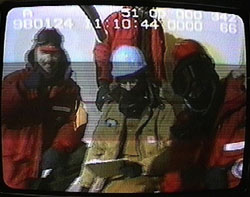
|

|
|
|
©
Per Olof Hulth
|
|
|
Checking
the list to make sure everything is in order.
|
|
|
|

A
literary essay about AMANDA by Francis Halzen
page 2
The
end result, abstracted on a computer screen, would have seemed
unremarkable to most people. But to us it was the sole trace
of a particle that had traversed vast distances to reach us,
perhaps a remnant of one of the most spectacular events in
the universe. More to the point, it was the first concrete
proof that AMANDA worked—that it could help map the distant
depths of space, thereby perhaps resolving some of the most
heated controversies in physics. Later, when I E-mailed the
diagram to our collaborators, one of them wrote back: "This
is why I’ve spent five years of my life on this project."
"NEUTRINOS, THEY ARE VERY SMALL," John Updike wrote,
famously. "They have no charge and have no mass / And
do not interact at all." As it turns out, Updike was
wrong on two counts, but he got the spirit right, anyway.
Neutrinos are so small and slippery that they pass through
the Earth (and stars and cities and most everything else)
like a bullet through a rainstorm. Unfazed by magnetic fields
or the strong nuclear force, they have to make a direct hit
on a proton to be stopped at all—a highly unlikely event.
At the same time, neutrinos are about as plentiful in the
universe as the photons that constitute light: 3 x 1016 of
them pass through our bodies every second.
That combination of factors makes neutrinos the best focus
for deep-space astronomy. Most photons cannot reach us from
the most distant points in the universe (the most energetic
ones cannot even make it from the edge of the galaxy: they
crash into microwave background radiation along the way).
And though radio waves routinely travel as far as neutrinos,
they are emitted even by rather mundane astronomical objects—the
moon, for instance. Neutrinos, on the other hand, not only
travel long distances, they are easy to categorize: low-energy
neutrinos are generated by the sun, by cosmic-ray collisions
in the upper atmosphere, and by other nearby phenomena; high-energy
neutrinos only reach the earth from distant, supremely violent
events—gamma-ray bursts, for instance, or black holes
at the center of new galaxies. By focusing on high-energy
neutrinos alone, a telescope can naturally filter out all
but the most interesting things in the sky.
But there is no free lunch. If neutrinos can fly through planets
without stopping, they hardly brake for your average telescope
mirror. In fact, neutrinos are so hard to detect that for
decades they existed only in theory. The Swiss theoretical
physicist Wolfgang Pauli "invented" them in 1930
to balance out the energy apparently lost when radioactive
matter decays. ("I have done a terrible thing,"
he told the German astronomer Walter Baade. "I have postulated
a particle that cannot be detected.") It was not until
twenty-six years later, when the physicists Frederick Reines
and Clyde L. Cowan built a neutrino detector near the Savannah
River nuclear plant in South Carolina, that the existence
of the particle was confirmed.
|
